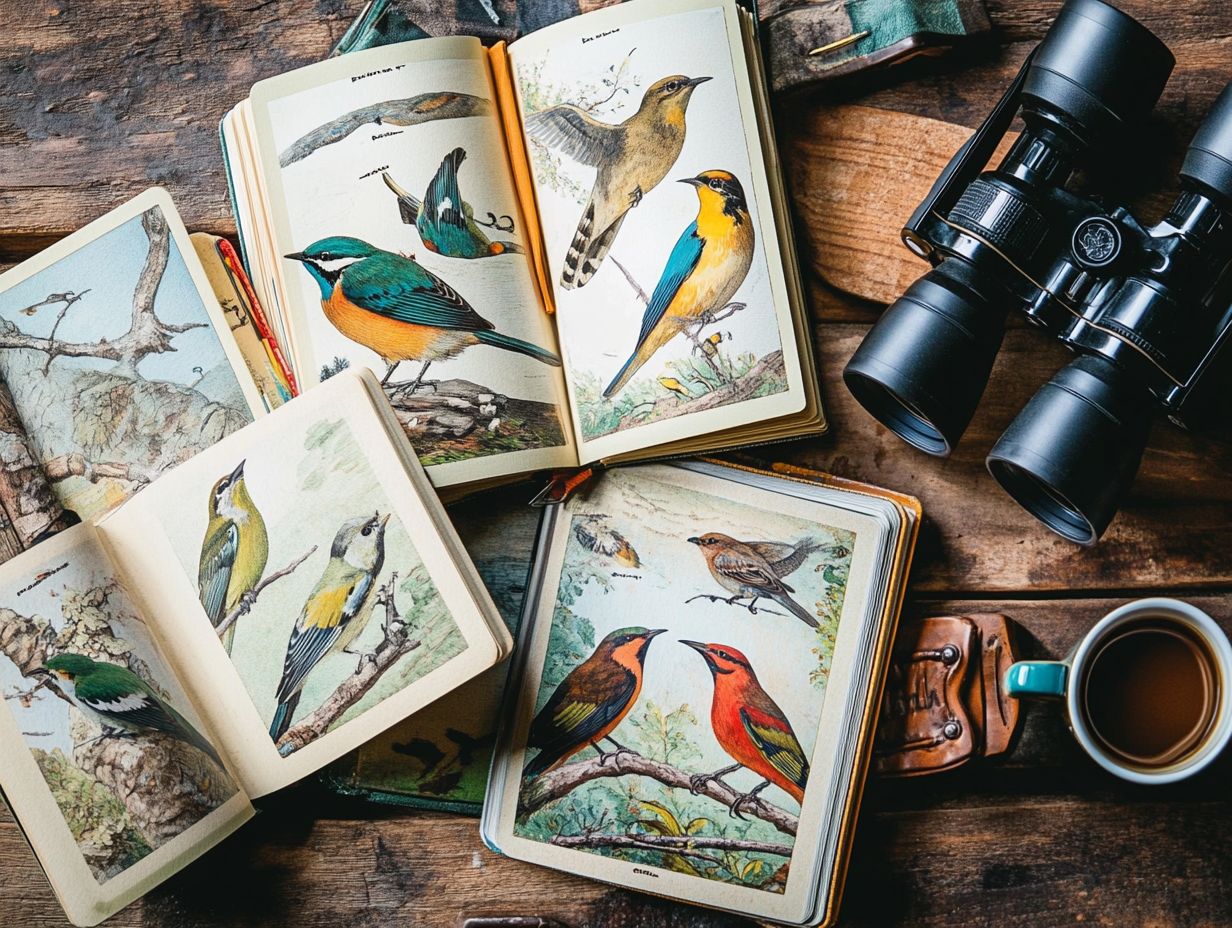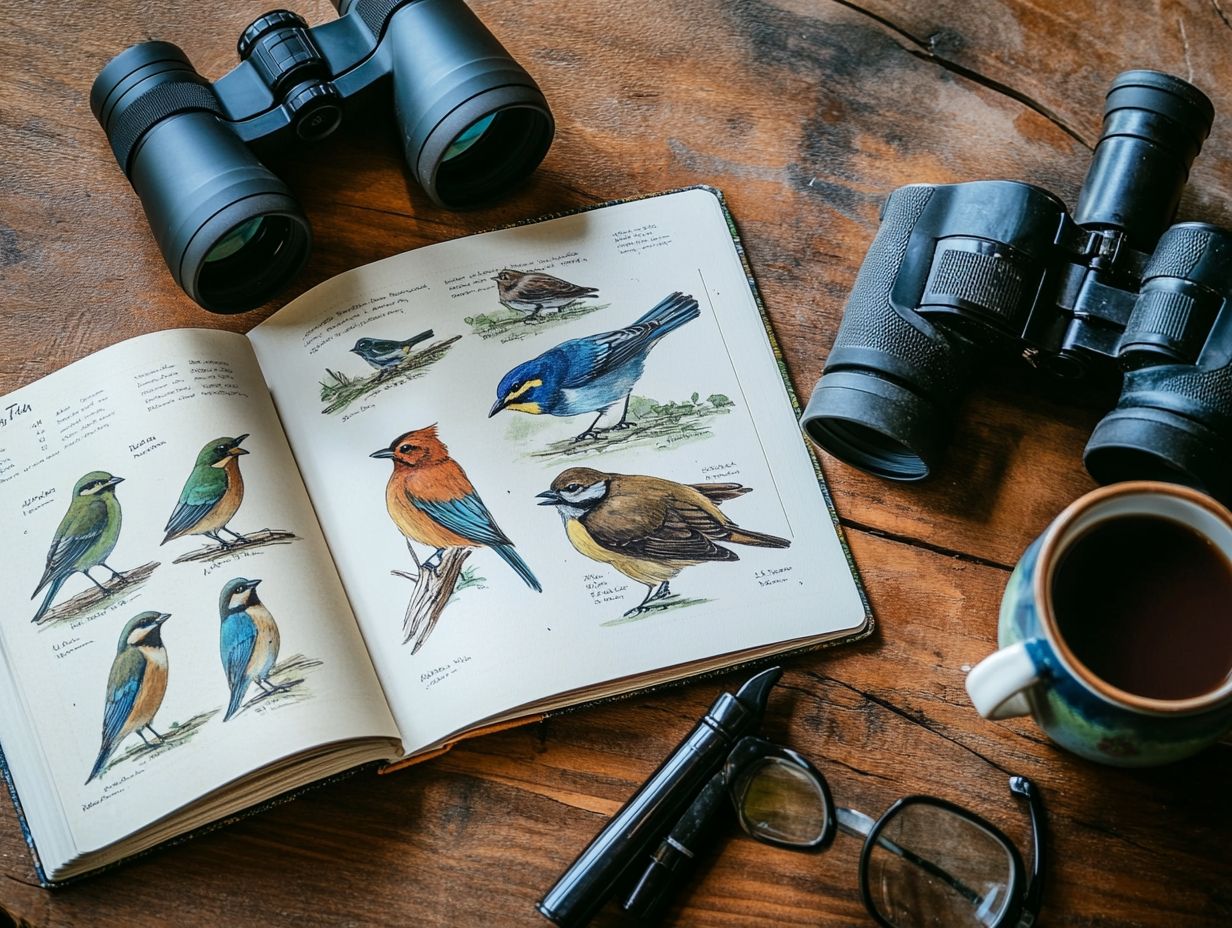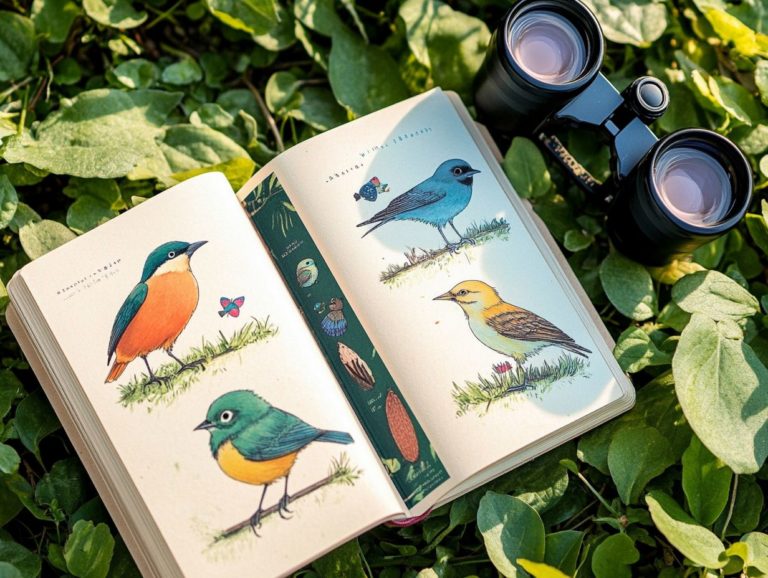Bird Watching Field Guides: A Comprehensive Overview
Bird watching is a delightful and enriching hobby that allows you to connect with nature and appreciate the beauty of avian life.
At the core of this enriching experience is the bird watching field guide a crucial tool for both beginners and seasoned birders alike.
This guide delves into what makes a good field guide, defining its purpose and exploring the various types available, whether in print or digital formats.
You’ll discover essential features to consider, along with tips for using these guides effectively. It also explains how these guides can boost your bird watching experiences and support conservation efforts.
Whether you’re aiming to identify your first sparrow or deepen your understanding of local species, this guide will provide you with the insights you need to elevate your birding journey.
Contents
- Key Takeaways:
- What is a Bird Watching Field Guide?
- Types of Bird Watching Field Guides
- Features to Look for in a Field Guide
- How to Use a Bird Watching Field Guide
- Why You Need a Bird Watching Field Guide!
- Frequently Asked Questions
- What are bird watching field guides?
- Why are bird watching field guides important?
- What should I look for in a good bird watching field guide?
- Are there different types of bird watching field guides?
- Do I need a bird watching field guide if I have a bird identification app?
- How can I use a bird watching field guide effectively?
Key Takeaways:

- A bird watching field guide helps identify and learn about different bird species in their natural habitats.
- There are various types of field guides, including print and digital versions, as well as regional and comprehensive guides.
- When choosing a field guide, look at the illustrations or photographs and the organizational structure.
What is a Bird Watching Field Guide?
A Bird Watching Field Guide is an essential reference tool crafted to assist you in identifying birds throughout North America, enhancing your experience with birdwatching techniques.
These guides offer detailed species accounts that encompass physical descriptions, habitats, and ecological impacts.
Published by esteemed organizations like the National Audubon Society and featuring renowned guides such as the Sibley Guide to Birds, they cater to both novice birdwatchers and experienced bird experts alike.
These field guides not only enhance your birdwatching experience but also play a vital role in conservation efforts, educating you on the significance of avian species and their habitats.
Types of Bird Watching Field Guides
Bird watching field guides come in a variety of formats, each boasting distinct advantages tailored to enhance your experience, such as those found in field guides: the art of birdwatching simplified.
Print guides, like the Peterson and Kaufman Field Guides, serve as tangible references, complete with well-organized features that make identification a breeze.
On the other hand, digital options such as the Cornell Lab’s Merlin Bird ID app and National Geographic’s All About Birds provide unmatched portability and interactive experiences.
Choose the format that excites you most whether it s the feel of a printed page or the convenience of an app.
Print vs. Digital Guides
When you’re considering Bird Watching Field Guides, the difference between print and digital formats is crucial, as each offers unique benefits that can elevate your bird identification skills.
Print guides often boast exquisite illustrations and detailed range maps, providing that tactile experience many traditional birdwatchers cherish.
On the other hand, digital guides present interactive tools and instant access to updates that are invaluable for identifying various bird species while you’re on the move.
Flipping through the pages of a well-organized print guide can create a deeper connection to the material. You might find that a beautifully illustrated field guide not only serves as a practical tool but also becomes a beloved companion on your birdwatching journeys.
Conversely, digital formats shine in terms of accessibility; they enable you to effortlessly search for specific birds, listen to sound recordings, and navigate extensive databases quickly. This caters to a wide range of users, from novice birders to seasoned bird experts.
This contrast emphasizes the variety of preferences among birdwatchers. Both print and digital formats offer unique features, ensuring every birdwatcher can find the right companion for their adventures.
Regional vs. Comprehensive Guides
Bird Watching Field Guides can be categorized into regional and comprehensive guides. Regional guides hone in on specific areas, offering detailed species accounts and insights into local habitats and effects on the environment. In contrast, comprehensive guides encompass a wider range of birds, making them essential for every birdwatcher eager to identify a diverse array of species across multiple regions.
These distinct approaches cater to the varied interests and expertise levels among birdwatchers. If you’re just starting out, regional guides can be particularly beneficial, helping you understand the local ecology and the unique species diversity present in specific locales. Conversely, seasoned observers or those on the move may find the extensive coverage of field guides invaluable, as they compile information about numerous species, making identification easier on a broader scale.
By utilizing these guides, you can deepen your appreciation for avian life while gaining valuable insights into conservation efforts and the environmental factors influencing bird populations.
Features to Look for in a Field Guide

Choose a bird watching field guide that highlights key features that elevate both bird identification and your overall experience. Pay attention to the quality of illustrations versus photographs, as well as how the guide is organized.
A well-crafted field guide should offer clear physical descriptions, comprehensive habitat information, and data curated by experts in bird studies, enabling you to swiftly and accurately identify birds in their natural surroundings.
Illustrations vs. Photographs
Choosing between illustrations and photographs can be thrilling! Each has its unique strengths for bird identification. While illustrations often provide stylistic and educational advantages, highlighting key characteristics of various bird species, photographs offer realistic context that can enhance your identification efforts during birdwatching.
This ongoing discussion reveals the strengths and weaknesses of each medium. For instance, field guides like the Peterson Field Guide to Birds leverage detailed illustrations that allow you to concentrate on crucial field marks think plumage patterns and shapes without the distractions that photographs might introduce.
On the flip side, guides such as The Sibley Guide to Birds pair these illustrations with high-quality photographic examples, enabling you to appreciate variations in real-life settings. However, be mindful that photographs can sometimes cause confusion due to differing lighting and angles, which may obscure a bird’s true colors or features.
As you traverse various environments, these strengths and limitations will significantly impact your identification success.
Organizational Structure
The organizational structure of a Bird Watching Field Guide is a crucial aspect often overlooked, yet it significantly influences its effectiveness as your go-to reference tool for identifying birds. The best guides typically arrange birds according to bird families or habitats, making it much easier for you to locate specific species accounts and grasp the ecological relationships at play.
This thoughtful arrangement not only helps you identify birds swiftly but also enriches your overall birdwatching experience by allowing you to explore avian life in a more meaningful context. For example, when birds are categorized by habitat, it encourages you to think about where you might spot certain species during different seasons or in various regions.
Ultimately, a well-organized field guide cultivates a deeper appreciation for avian diversity, as you can effortlessly compare the similarities and differences among species, all while understanding how they are categorized.
How to Use a Bird Watching Field Guide
To use a Bird Watching Field Guide effectively, grasp its layout and features, along with key tips for identification and navigation that can elevate your birdwatching experience.
Familiarize yourself with the guide’s organizational structure. Use detailed illustrations and photographs for precise identification, and consult the range maps to learn about the habitats and behaviors of different bird species.
This approach enriches your birdwatching adventures and deepens your connection to the bird-related world.
To enhance your experience with a Bird Watching Field Guide, use targeted identification tips and navigation strategies as you explore the fascinating realm of birdwatching.
Start by getting to know the layout of the field guide. Pay attention to how species accounts are organized and leverage visual cues from illustrations and photographs for quick identification.
Observing bird behavior offers valuable context. For instance, noting whether a bird is feeding, soaring, or perched can help narrow down your options. Keep an eye on distinctive physical features like coloration, size, and bill shape. These traits are essential for precise identification.
Using range maps helps you understand where different birds live, which increases your chances of spotting them in the wild.
Efficiently navigating the guide means being attuned to your surroundings, allowing you to transition smoothly from one species to another as you immerse yourself in the captivating world of bird life.
Why You Need a Bird Watching Field Guide!

Using a Bird Watching Field Guide offers a wealth of benefits that greatly enhance your birdwatching experience. These guides provide valuable information about conservation efforts and bird behavior, equipping both novice and seasoned birdwatchers with the tools needed to identify various species confidently.
This fosters a deeper appreciation for biodiversity and encourages you to explore the outdoors more fully. As you learn about the ecological roles of birds, you’ll feel more inclined to engage in conservation initiatives that protect their habitats.
Enhancing Your Bird Watching Experience
A Bird Watching Field Guide is your key to an amazing birdwatching adventure! It offers detailed information and insights, such as those found in building your birdwatching knowledge, that deepen your connection with the great outdoors.
As you explore different bird species through the guide’s vivid illustrations and comprehensive accounts, your understanding and appreciation for nature will blossom, transforming your birdwatching adventures into something truly fulfilling.
By discovering the unique traits of various birds like their calls, behaviors, and habitats you can develop a richer relationship with your environment. These guides encourage you to observe mindfully, prompting you to notice subtle shifts in both the landscape and bird activity.
The ability to identify and appreciate diverse species not only brings personal satisfaction but also enhances your awareness of bird biodiversity, instilling a sense of responsibility for their conservation.
These skills can transform casual outings into enlightening experiences, making each moment spent birdwatching even more rewarding.
Don’t wait grab your field guide and start your birdwatching journey today!
Contribution to Conservation Efforts
Field guides elevate your birdwatching experiences. They play a crucial role in vital conservation efforts by raising awareness about the ecological significance of birds and their habitats.
Organizations like the National Audubon Society highlight the importance of educating the birding community, enabling you to take proactive steps in preserving bird species and their environments.
These guides often provide in-depth insights into the various species’ roles within ecosystems. They illustrate how certain birds can serve as indicators of environmental health.
By understanding these details, you can actively support local conservation projects, whether that means engaging in habitat restoration programs or participating in citizen science initiatives.
Active involvement in local bird counts allows you to track changes in bird populations, leading to more informed conservation strategies. Ultimately, the knowledge you gain from these resources deepens your connection to nature and inspires you to become a steward of the environment.
Frequently Asked Questions
What are bird watching field guides?
Bird watching field guides are books or resources that provide information and illustrations of different species of birds, their habitats, behaviors, and identification tips. For a comprehensive resource, consider field guides: navigating the world of birds, which often include illustrations vs photographs for enhanced clarity.
Why are bird watching field guides important?

Bird watching field guides are important because they serve as a reference for bird watchers to identify and learn about different bird species. For those getting started, a beginner’s guide to birdwatching can provide valuable information about their habitats, behaviors, and migration patterns.
What should I look for in a good bird watching field guide?
A good bird watching field guide should have accurate and detailed information, clear and high-quality illustrations or photographs, and be organized in an easy-to-use format. It should also include a map or index to help locate specific bird species.
Are there different types of bird watching field guides?
Yes, there are different types of bird watching field guides. Some are specific to a particular region or type of bird, while others are more comprehensive and cover a variety of species. There are also digital field guides available as apps or online resources.
Do I need a bird watching field guide if I have a bird identification app?
While bird identification apps can be a useful tool, a bird watching field guide can provide more in-depth information and illustrations. They also do not require a phone or internet connection, making them a reliable resource to have in the field.
How can I use a bird watching field guide effectively?
To use a bird watching field guide effectively, familiarize yourself with the layout and organization of the guide. Use visual cues, such as color or shape, to search for specific types of birds. Make notes or sketches of the birds you see for easier identification later on.
Bird watching field guides are essential tools for anyone looking to deepen their connection with nature. Grab your field guide today and embark on an exciting adventure in birdwatching!






